AMARANTH
– Amaranthus hypochondriacus, caudatus, tricolor
Heirloom; Often dubbed a ‘superfood’.
Colourful leaves of rich red, yellow and green add
an explosion of color to your dishes. The young greens
are a delicious addition to salads, with a flavour
similar to spinach. The larger leaves are healthful
and delicious when steamed, sautéed or used
in soups. Mature seed heads will yield protein-packed
seeds with a rich nutty taste, used on their own,
or ground as grain for a non-gluten flour. Amaranth
seeds are about 16% protein compared to 10% for most
grains, and the protein has a balanced amino acid
profile especially high in lysine. Combining amaranth
with other grains complements their protein and boosts
their nutritional value. The seeds contain calcium,
iron, phosphorous and fibre. The leaves are high in
protein, as well as beta carotene, iron, calcium and
fibre. 3 Varieties: Early Splendor, Tri-colour (Joseph’s
Coat – shown in picture), Vegetable
ANISE-HYSSOP
– Agastache foeniculum
Both the flowers and the leaves of this herb have
a delicate anise or liquorice flavour. The blossoms
make attractive plate garnishes and are often used
in Chinese-style dishes.
It also makes a delightful tea...
ARUGULA
Flowers – Eruca vesicaria sativa
Delicate & white, slightly nutty taste. The Salad
Green has a spicy peppery flavour, a spinach-type
green. It is usually appreciated raw in salads or
on sandwiches, while the flowers can be used in salad
for a light piquant flavour.
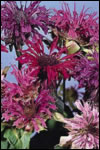 BERGAMOT
(Bee Balm) – Monarda didyma BERGAMOT
(Bee Balm) – Monarda didyma
A citrusy fragrance reminiscent of lemon and orange.
Brilliant blooms in a range of red, pink and purple
shades. Blooms and leaves can be added to salads –
both regular and fruit salads. Leaves can be harvested
for tea, and taste like the main ingredient in Earl
Gray Tea. Any place you can use oregano you can use
bee balm blossoms.
Also: LEMON BERGAMOT – as above, but with a
stronger lemon scent & flavour.
BORAGE
Flowers – Borago officinalis
Two types available - White and Blue delicate blooms.
Blossoms have a cool, cucumber taste. Wonderful in
punches, lemonade, gin and tonics, sorbets, chilled
soups, cheese tortes and dips. On hot summer days
cool off with iced borage tea, adding honey and lemon
juice to taste.
CALENDULA
(Pot Marigold) – Calendula officinalis
Heirloom. Featuring a brilliant range of yellow-orange-red
coloured blooms. A wonderful edible flower. Flavours
range from spicy to bitter, tangy to peppery. The
taste resembles saffron, and is often used as a substitute.
Sprinkle them on soups, pasta or rice dishes, herb
butters, and salads. Petals add a yellow tint and
delicate flavour to spreads, scrambled eggs, omelettes,
and cheese. Use dried & crumbled Calendula petals
in rice, noodles, cream soups, and broths.
BACHELOR'S
BUTTONS (Cornflower) – Centaurea cyanus
Delicate, brightly coloured flowers in a wide mix
of colours - black, blue, rose, white, lavender and
pink, with many bi-colours. . These have a slightly
sweet to spicy, clove-like favour. Most commonly used
as a garnish. n.b. Only the petals of these composite
flowers are edible. (The pollen of composite flowers
is highly allergenic and may cause reactions in sensitive
individuals).
CHAMOMILE
– Chamaemelum nobile, Matricaria recutita &
M. chamomilla
The flowers are small and daisy-like and have a sweet,
apple-like flavour. White with yellow centres. Excellent
for teas, great for the digestive system.
CHIVE
Flowers – Allium schoenoprasum
All parts of these plants are edible. Lovely purple
round blooms. Use whenever a light oniony flavour
and aroma is desired. The blue/purple flowers tend
to have a stronger flavour than the leaves & young
developing seed heads are even stronger. Separate
the florets and enjoy the mild, onion flavour in a
variety of dishes, particularly in salads. Leaves
can be cooked as flavouring with other vegetables
in soups etc.
GARLIC CHIVE BLOSSOMS - Allium tuberosum – White
blossoms with a mild garlic flavour.
WILD CLOVER
Flowers – Trifolium species
Perfect round white, pink, and purple blooms. Sweet,
anise-like flavour; n.b. Raw flowerheads can be difficult
to digest.
DAY LILIES
– Hemerocallis aurantia
Slightly sweet with a mild vegetable/bean flavour,
like sweet lettuce or melon. Their flavour is a combination
of asparagus and zucchini. To use in desserts, cut
them away from the bitter white base of the flower.
Also great to stuff like squash blossoms, and you
can dip them in batter & deep-fry as Day-lily
tempura. Flowers look beautiful on salad platters
or crowning frosting on a cake. Available colours:
bright yellow, purple, orange.
DIANTHUS
(Carnations, Pinks) – Dianthus barbatus
Dianthus are the miniature member of the carnation
family. Flowers occur in small clusters of fragrant
'Sweet William' type flowers, with a clove-like or
nutmeg scent, some heavily scented. To use the sweet
petals in desserts, cut them away from the bitter
white base of the flower. . Petals add colour to salads
or aspics. Steep in wine, candy, or use as cake decoration.
7 Varieties: Albus, Bouquet purple, Rainbow Loveliness
(heavily clove scented), Fenbow nutmeg (red), Holborns
Glory Black, Clove-Pink, Mini Spice Mix;
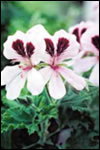 GERANIUMS,
Edible,Scented – Pelargoniums – Hard to
Find – GERANIUMS,
Edible,Scented – Pelargoniums – Hard to
Find –
Specifically for gourmet dishes. They come in fragrances
from citrus and spice to fruits and flowers, usually
in colours of pinks and pastels. Sprinkle them over
desserts and in refreshing drinks or freeze in ice
cubes. Can also be used in salads and in desserts.
5 Varieties: Old Fashioned Rose, Lime, Coral Austrian
(Trailing), Nutmeg, Prince of Orange (pictured). The
scent of the leaves (especially LIME) is amazing.
GLADIOLAS
– Gladiolus species
Flowers (anthers removed) have a flavour vaguely like
lettuce, but make lovely receptacles for sweet or
savoury spreads or mousses. Toss individual petals
in salads. More than a dozen varieties and colours
available including Arabian nights (deep red), Pink
& Purple, plus orange, green, blue, yellow etc.
as well as black & white.
LAVENDER
– Lavandula angustifolia
Wonderful sweet floral flavour with lemon and citrus
notes in these purple-pink-blue blooms. Flowers look
beautiful and taste great in a glass of champagne,
with chocolate cake, or as a garnish for sorbets or
ice creams. Lavender also lends itself to savoury
dishes from hearty stews to wine-reduced sauces. Diminutive
blooms add a lovely scent to custards, flans or sorbets.
Varieties available: Lavender Lady, Munstead and Vera.
Also available as certified organic dried lavender
buds: chef-ready!
HOLLYHOCKS
– Alcea rosea
Blends of colourful pastel and dark shades for a rich
look. Flavour is very mild. Varieties in 2005: Indian
Spring (Red, Rose, White); Single Black Hollyhock;
Queeny Purple;
LEMON VERBENA
FLOWER – Aloysia triphylla
Tiny cream-coloured citrus-scented blossoms. Sweet,
strongly lemon-flavoured leaves. The leaves and flowers
can be steeped as an herb tea, and used to flavour
custards, sweet salads, sauces and flans.
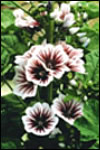 MALVA
– Malva moschata, m. sylvestris,
m. alcea, m. verticullata MALVA
– Malva moschata, m. sylvestris,
m. alcea, m. verticullata
An old-fashioned favourite. Young leaves and shoots
may be eaten raw in salads or cooked with vegetables.
The unripe seed capsules (called ‘cheeses’),
are delicious in salads. 2 inch cup-shaped blooms.
2 varieties: purple and white.
MARIGOLDS
– Tagetes tenuifolia (signata)
Mounds of brilliant scented yellow, tangerine, red
flowers. Dainty star-like blooms. Different species
of marigolds have a range of flavours from mildly
herbal to bitter. All Marigolds are edible, but while
African and French Marigolds make gorgeous garnishes,
they are too bitter to eat. Pot (Calendula –
see above) and Signet Marigolds taste best. These
are Signet marigolds. The tiny petals of "Lemon
Gem" and "Tangerine Gem" are mild and
tasty. Excellent for salads, dips, sauces and custards,
in breads and muffins or infused in butter or oil.
"The secret of the famous Dutch soups, color
and flavor, was the use of the marigold. Mediaeval
French and English cooks liked it too." from
Flower Cookery by Mary MacNicol
Available Varieties: Lemon Yellow, Tangerine Gem,
Lemon Gem
MINT FLOWERS
– Mentha species
Tiny usually white flowers, in the flavour of the
mint variety; make a delicate addition to desserts
and salads...
MUSTARD
FLOWERS – Brassica nigra, B sinapsis
alba
Tiny flowers with a spicy taste. Young leaves can
be steamed, used as an herb, eaten raw, or cooked
like spinach. Flowers add a pungent dash of flavour
to salads. Seeds may be used whole in curries or pickling,
or ground to make mustard. n.b. Some people are highly
allergic to mustard; use blossoms with care, they
can be bitter. Start with a small amount. Varieties
available: Sawtooth, White, Chinese, Red Giant.
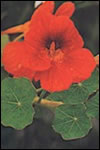 NASTURTIUMS
– Tropaeolum majus NASTURTIUMS
– Tropaeolum majus
Large, semi-double blooms in seven brilliant colors
ranging from trailing to upright, with peppery flavours.
They rank amoungst the most well-known edible flowers.
Blossoms have a sweet, spicy flavour similar to watercress.
Stuff whole flowers with savoury mousse. Leaves add
pepper flavour to salads, hors d’oeuvres, and
to mustard dressings. Pickled seed pods are less expensive
substitute for capers. Use entire flowers to garnish
platters, salads, cheese tortes, open-faced sandwiches,
and savoury appetizers.
Varieties Available: Black Velvet, Cherry Rose, Empress
of India, Glorious Gleams, Golden King, Jewel Mix,
King Theodore (velvet crimson), Moonlight, Whirlybird
Scarlet.
PANSY –
Viola x wittrockiana
Delicate, mixed and vibrant individual shades available
in large and miniature sizes of blooms. If you eat
only the petals, the flavour is extremely mild and
slightly minty. If you eat the whole flower, there
is a winter, green overtone. The whole flower is useful
as a container to stuff with soft cheeses or guacamole
and presented on a cracker. The chopped leaves and
petals may be used to flavour oils, vinegars, and
dressings or to add to butters and soft cheeses. The
petals are wonderful used as a garnish, in syrup or
candied. Add to fruit salads, green salad, desserts
and soups. 6 Varieties and many colours: Yellow, Orange,
Raspberry Rose, Light & Dark Blue, Dark Orange
with ‘whiskers’ etc.
POPPIES
– Papaver rhoeas
The fascination of these light or dark flowers continues.
Use the Poppy Seeds in traditional ways, or use the
flowers. Poppy seeds are commonly used in breads,
cookies, rolls, cakes, biscuits, and pastries to add
texture and a mild, nutty flavour. You can candy poppy
flowers by using corn syrup and arabic gum and then
sprinkle powdered sugar on top before they have dried.
ROSES
– Rosa species
Lots of colours & different types of blooms to
choose from, some heavenly scented. If roses smell
good, the petals will taste good. All roses are edible,
and each variety tastes different, but it is usually
the older/ heirloom species that have the most flavour.
Use for decoration, with ice-cream or sorbet, or to
float in festive punches & finger bowls. Make
rose butter or use in salads. Great in vinegars or
jellies. Rosehips can be eaten raw and are said to
have 400 times more vitamin C than orange juice. Use
steeped for a healthful tea, hot or cold.
SAGE FLOWERS
– Salvia officinalis
Sage flowers are similar in taste to the leaves but
have a subtler flavour with more sweetness. Add them
to salads, use as a garnish for cream soups, frittatas
or roast venison. Blossoms may be minced and added
to soft cheeses or in sweet butter. Flowers are a
delicious companion to many foods including beans,
corn dishes, sauteed or stuffed mushrooms, or pesto
sauce.
SCARLET
RUNNER BEANS – Phaseolus coccineus
Beans with blooms in a variety of bright colours.
Flowers or beans can be eaten, but as they toughen
as they age, the beans are best used young. To some
people runner beans are the best type of beans. Blooms
taste like the beans with a touch of sweetness, and
are crunchy in texture. There is a sweet nectar at
the base of each flower so don't remove the base.
Use to top soups, in salads, and as a garnish. Enjoy
this long season crop in red, white and pink flowered
varieties.
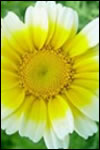 SHUNGIKU
(Crown Daisy Chrysanthemums, Garland Round Leaf) –
Chrysanthemum coronarium SHUNGIKU
(Crown Daisy Chrysanthemums, Garland Round Leaf) –
Chrysanthemum coronarium
Tangy, slightly bitter taste, from faint peppery to
mild cauliflower. Scatter petals on a salad, or use
in soups, sauces, poultry, seafood, baked products,
and with lamb. Pickle the flower heads or leaves in
vinegar, or blanch them and serve with soya for seasoned
tofu. Always remove the bitter flower base and use
petals only. Edible young leaves are used for flavouring
salads, or in chop suey and stir fries. Chrysanthemum
flowers can also be served deep-fried in a light tempura
batter.
SNAPDRAGONS
– Antirrhinum majus
A bright mix of individual large and extra large florets.
Sprinkle snapdragons on green salads and fruit salads,
or use them as an edible garnish. Delicate garden
variety can be bland to bitter. Flavours depend on
type, color, and soil conditions. Colours available:
Lavender, Red, White, Yellow, Mixed
SQUASH,
MARROW, PUMPKIN & ZUCCHINI FLOWERS –
Cucurbita pepo species
Yes, you can cook with all of these yellow/orange
blooms. Use male flowers (those with the single tubular
stamen) which don't bare fruit. Squash and pumpkin
blossoms are edible and taste mildly of raw squash;
try the zucchini flower, delicious fried or stuffed.
All are great stuffed with cheeses, bread crumbs or
meat mixtures and then deep-fried. When stuffing,
leave the stems on but otherwise remove the stamens
and pistils. The blossoms may be sliced and added
to a variety of dishes including soufflés,
frittatas, scrambled eggs, and burritos. Note: They
wilt quickly so pick just before you are going to
use them.
TULIP PETALS
– Tulipa species
Tulips are a most unexpected flower on a plate, and
add an exotic colour. Flavour varies from tulip to
tulip, but generally the petals taste like sweet lettuce,
fresh baby peas, or a cucumber-like texture and flavor.
Remove the stamens and pistil, then serve the tulip
whole as a cup or separate the individual petals.
Tulip petals may be added to salads and sandwiches.
Try stuffing the whole flowers with shrimp or chicken
salad, or combine with crab and asparagus for an interesting
appetizer. The bulbs could, if you were really in
a pinch, be diced and used in spaghetti sauce if you
happened to run out of the tulip’s more commonly
eaten relative: the onion. For dessert, stuff with
chocolate mousse, champagne sorbet or lime sherbet.
NOTE: Some people have had strong allergic reactions
to them. If touching them flower causes a rash, numbness
etc. don't eat them, and never eat the bulbs.
SUNFLOWERS
– Helianthus annuus
The flower is best eaten in the unopened bud stage
when it tastes similar to artichokes, and can be steamed.
Once the flower opens, the petals may be used like
chrysanthemums, and the flavour is distinctly bittersweet,
tasting leafy. Lightly steam petals to lessen bitterness.
14 Varieties available!
VIOLAS
(Johnny Jump-Ups) – Viola odorata
Heirloom flower. Lovely yellow, white and purple blooms,
which have a mild wintergreen flavour and can be used
in salads to decorate cakes, or served with soft cheese.
They are also a great addition to drinks, soups, or
desserts. Dwarf, bushy plants provide masses of tiny
blooms. 6 Varieties available: Bowles Black, Helen
Mount (pictured), Velvet Blue Bronze, Orchid Frost,
Primrose, Violet Flaire.

|